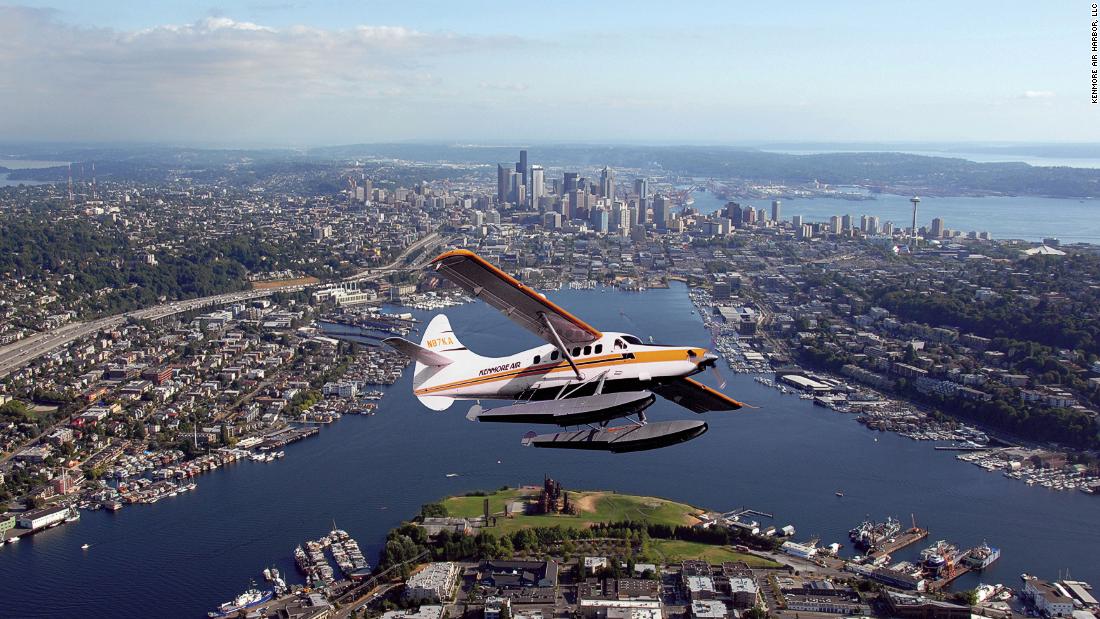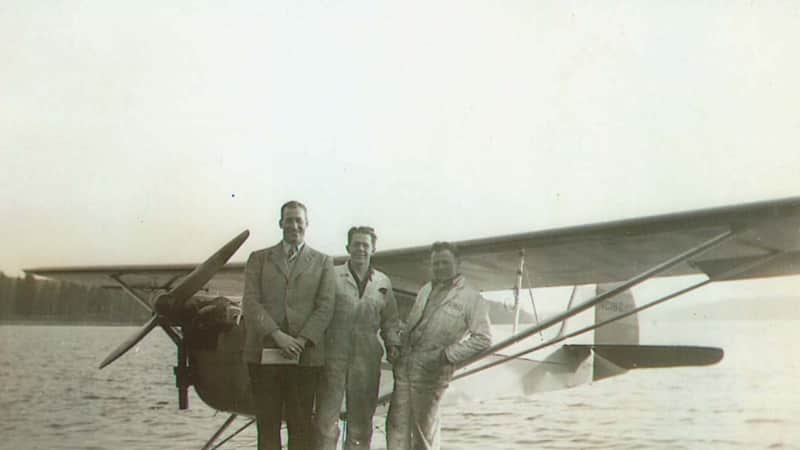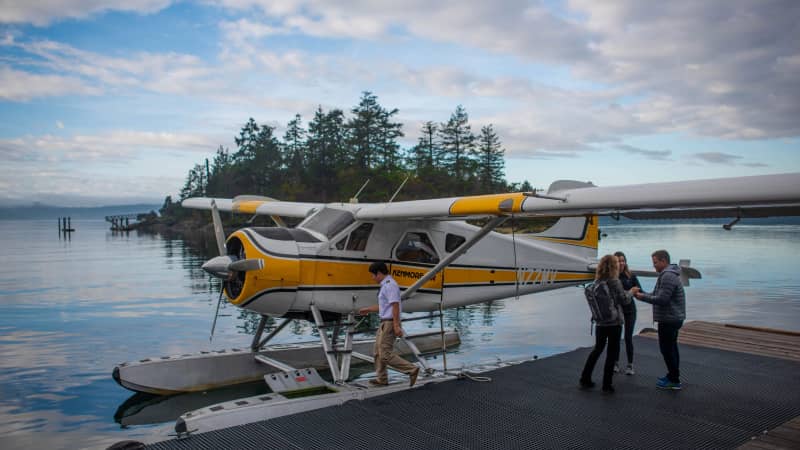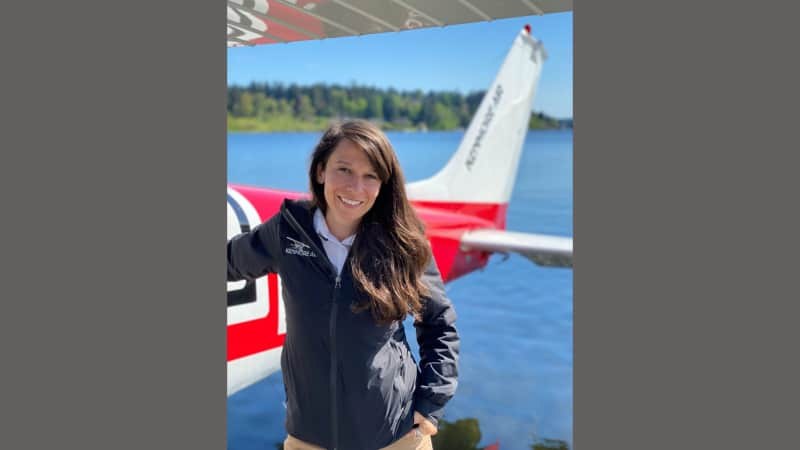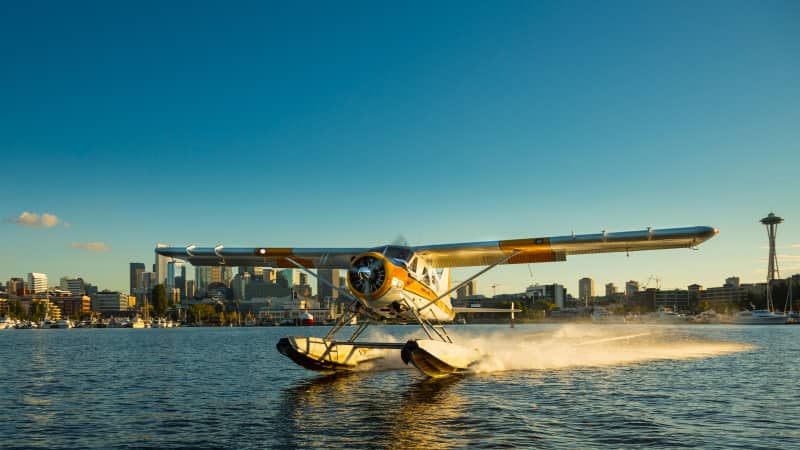(CNN) — Think of Seattle, and what springs to mind? The Space Needle, for sure. Pike Place Market, almost certainly. For many, there’s another classic sight in the Emerald City: the tiny seaplanes darting up and down, making a runway out of the water that surrounds the city.
A 75th anniversary is a major achievement for any airline, of course — especially after a year in which even major airlines have gone out of business thanks to the pandemic.
But it seems that Kenmore Air’s micro-focused approach — it flies year-round from Seattle to the San Juan Islands, an archipelago around 90 miles north, as well as to Victoria, BC — as well as an all-encompassing attitude (they also repair other companies’ planes and manufacture parts) have served it well.
That and, perhaps, the close relationships it has fostered with employees and customers.
“Customers aren’t just seen as people providing money for the company, they’re part of Kenmore too,” says pilot Amanda Grimwood. “I’d say the biggest thing that sticks out is the integrity of the company — there’s a lot to be said for knowing that they will always do the right thing, and the customer really sees that.”
In fact, one customer loved it so much that he bought into the business. Howard Wright, a local entrepreneur and pilot, has a 49% holding in the company. “He’d been a customer of ours for over 50 years, and his family had been longtime customers too,” says Kenmore Air director, Todd Banks.
A family affair
Kenmore Air’s history goes back to March 21, 1946, when Robert Munro, Jack Mines and Reg Collins converted an old shingle mill on Lake Washington into a seaplane harbor, and their first flight took off.
Mines was flying the floatplane; his cofounders had rebuilt it. In fact, the plan back then was to do maintenance on the planes, and offer flying lessons (regulatory approval came the following year.)
The company went on to offer charter flights to sportspeople and anglers wanting to travel around Puget sound. It also became a dealership for Cessna and Seabee planes, adding Beavers in 1966. By 2020, the company had either restored or modified 150 Beavers.
Robert Munro — known as Bob — headed up the company for over 50 years. He retired in March 2000, just seven months before he died. Today, his grandson, Todd Banks — who joined the company in 1992 as a parts seller — is president of Kenmore Air. He calls himself a “steward” of his grandfather’s company. His uncle, Gregg Munro, is company chairman.
Today, it’s the largest seaplane company in the United States.
Carrying the family business forward is a responsibility, says Banks: “I just have to make sure I’m not the one who screws it up.”
He puts Kenmore’s longevity down to its diversity.
“We’re in a very interesting niche of aviation: seaplanes,” he says.
“But I think what has kept us here is that although we’re small, we’re pretty diverse. Most people in Seattle know the airline side of our business, but we also have maintenance and repair operations, so we maintain other people’s planes, and we have FAA authority to make parts, too.
“The diversity has really helped us get through rough spots over the 75 years — so that’s been an advantage from the start.”
The company repairs planes from Alaska and Canada, and sells parts to clients as far away as Lake Como, in Italy.
“The pandemic certainly challenged us, and there were some hard, hard days trying to figure out how to navigate it, but parts and maintenance stayed fairly steady even when we weren’t able to fly, so we really leaned on that side of the business,” says Banks.
Crippled by the coronavirus crisis
He isn’t exaggerating when he talks of challenges. On the airline side, the previous 50 departures a day to Canada (in peak season) went down to just four a week at the height of the pandemic.
“It was rough,” says Banks. Their commuter traffic — people who live in the San Juan islands but hit the office in Seattle a couple of times a week — “died off.” Like many, much larger airlines, Kenmore resorted to doing PPE drops.
With the Canadian border still closed, they’re doing 2-3% of their normal business there. “We’re not out of the woods yet,” he says. But it seems the company’s historically good relationships with its employees will pay off.
“We’re very fortunate — people feel a real sense of commitment to the company. You have to trust who’s going to stick with you, and everyone did,” he says.
Supporting women in aviation
Maintaining good relations — whether with the staff or the customers — was a central tenet of the company from the start. Previous employees have spoken about Bob Munro’s genuine commitment to them, and current members of staff speak along the same lines.
Seaplane instructor Amanda Grimwood has been with the company for three years.
“I started by answering the phones — I was a pilot at the time but didn’t have a float rating, and wanted in any way I could,” she says. From the phones, she worked her way up through dispatch, then charters, into flight instruction.
“There was such a different atmosphere here, I can’t really explain it — it was just really comfortable,” she says.
“They immediately seemed to have a real love for what they were doing and people they were going to interact with, and I was fascinated.
“Normally there’s more competitiveness, or an eagerness to fly certain airplanes, or get as many air miles as possible, or money — it’s easy to get distracted flying massive airliners. But people are here because they want to be here, and the owners have made it an atmosphere that’s hard to find anywhere else. You’d never meet the owner of your company normally, but I see mine all the time.”
Grimwood is one of several female pilots working at Kenmore, and says there’s perhaps a reason they’re drawn to the company — even though female seaplane pilots are usually even rarer than female pilots of wheeled planes.
“In general, a lot of female pilots feel they have to prove something and keep up with everyone else — but although I’m still a minority here, I feel I’m just another pilot. In other places it’s not like that — sometimes there’s a bit of aggression, and sometimes if you’re the only female there’s a feeling of not being respected. I felt uncomfortable a lot in the past, but here I’m just one of the pilots, and I’m really thankful for that.”
Christina Rzeplinski, assistant chief pilot for the company’s wheeled division, Kenmore Air Express, agrees. Half the full-time pilots in this division are women — as well as many of the dispatchers and customer service staff. And, she says, customers take note.
“One thing I get a lot is, ‘Oh, you’re a female’ — and every time I say, ‘Yes I am.’ But most of our passengers are so excited to have female captains that they make a point of talking to you about it — maybe their family had a female pilot, or a woman who had always wanted to be a pilot.”
Todd Banks says the relatively strong female presence isn’t actually intentional.
“I should say it is, but no — it doesn’t matter, as long as they’re good and doing their job and take care of passengers in the way we like them to,” he says.
“It goes back to the basics of our culture — treating customers as we’d want family members to be treated. Attitude is as important as flying skills for us.
“We have a little bit of curiosity with a small number of people who’ll say, ‘Oh, there’s a woman flying this flight,’ but I’ve never had anyone who said, ‘I don’t want to fly with a woman. If we did, we’d probably tell them we were unable to meet their expectations and politely decline their business.”
He stresses, though, that although they don’t set out to employ women, we’re “definitely not neutral” about encouraging women into aviation — and says he’d love to see more women in maintenance, as well as in the flight deck. It looks like the enthusiasm runs in the family — his 23-year-old daughter is already flying.
The seaplane experience
If you’ve never flown in a seaplane before, you’re missing out.
Although Grimwood flies at 90 mph while training — they’re practicing take-off and landing, she says — her colleagues in the company’s mix of deHavilland Otters and Beavers, plus a couple of Cessnas, go at 100-120 mph.
Added to the (relatively) slow speed is a very low height — about 1,500-2,000 feet, compared to around 30,000 for a standard commercial aircraft. “You can see everything, you feel like you’re part of the landscape,” says Grimwood.
“I remember my first time in a seaplane — we came round the corner into the harbor, we saw Mount Rainier in the background, and I just thought, ‘How do people get paid to do this?'”
Banks says that nervous fliers tend to feel better about seaplanes: “We fly low and can see what’s happening, and we’re over our runway 90% of the time.”
Even Christina Rzeplinski, who flies the airline’s “normal” wheeled planes, admits, “there’s nothing like a seaplane.”
“Landing on water is the smoothest landing you’ll ever have — it’s just a thrill,” she says.
“The San Juan islands are stunning — as you’re descending into the harbor, there’s really nothing like it.”
From northern California, she came to Seattle to get her seaplane rating here and never left.
But she picked the wheeled planes in the end, flying out of Boeing Field — which she calls, “kind of the private version of Sea-Tac” (Seattle-Tacoma Airport) — because most of all, she loves flying in the clouds.
“I just love popping out of them and being on top, seeing nothing below but clouds — it puts a smile on my face,” she says.
In contrast, Grimwood, who grew up in Florida and Maine, likes the rain in Washington because it keeps her on her toes.
An electric future?
In normal times, as well as the year-round flights, Kenmore operates summer routes around British Columbia, from Vancouver Island and island-hopping, as far north as Port Hardy.
And as for their San Juan-Seattle route, normally the seats will be filled by people going to see their grandparents who’ve retired to the islands, elderly islanders coming to Seattle for healthcare, or those regular commuters, who use 10-ticket booklets.
The pandemic has certainly changed them. They’ve gone from 160 employees to around 80, currently — and that’s an improvement on the 18 that were around in March 2020.
It’s a long way from the 250 members of staff they had before the 2008 financial crash, too. But their willingness to go slow is what has kept them afloat, says Banks.
“We have reasonable expectations, and growth hasn’t always been a huge motivator — we want to do a good job for our existing customer base first.”
He says they still keep in touch with their pre-pandemic employees, and hope to bring more back once the Canadian border reopens. “Every time someone comes back it’s like a party,” he says.
In its anniversary year, despite the pandemic, Kenmore Air is looking to the future. So can “the little airline that could” last another 75 years? Banks hopes so — and with all three of his kids having expressed an interest in different parts of the business, he thinks it might even stay in the family.
As for what might change in the future, he says he’s excited about the prospect of electric planes — “if those take off, it could be pretty neat.”
“I hope we’ll still be taking customers into adventurous, beautiful places,” he says.
“I don’t know what kind of plane that’ll be on, but I think there’ll always be a need, and we have a niche, and hopefully there will be a part for us to play.”
